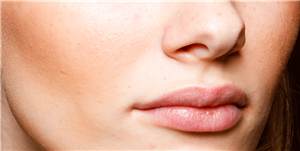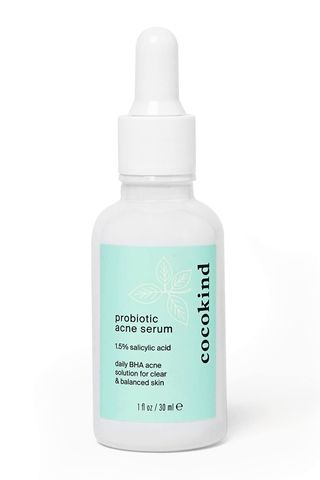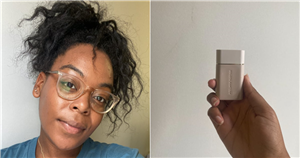Whether it’s a throbbing pimple in the middle of your forehead or a slew of clogged pores and blackheads across your nose, it’s tough to think of any skin issue more frustrating than acne. But while breakouts on certain parts of your face can be directly attributed to stress or hormonal imbalances—which means their treatment plan is often a bit more straightforward—acne on your cheeks can be a bit more challenging to figure out, since your cheeks come into contact with so many things every day (like your phone, makeup, hair, pillowcases, etc.).
But don’t worry: Cheek breakouts are definitely possible to treat, especially when you figure out their exact cause. And to help you out, I chatted with dermatologists Rebecca Marcus, MD; Joshua Zeichner, MD; and Adam Luber, MD, to walk you through everything you need to know about cheek acne, from what may be causing the acne on your cheeks to how to quickly get rid of pimples on your face fast.
What does cheek acne look like?
Unlike on your T-zone area, it’s rare that the cheeks see many blackheads or whiteheads. Instead, “the cheeks are usually prone to inflammatory papules, pustules, nodules, and cystic acne,” says Dr. Marcus. Basically, the red, angry, and notoriously difficult-to-get-rid of lesions are the ones that most commonly affect the cheeks. Fun.
What causes cheek acne?
Cheek acne is typically caused by oil that gets trapped within pores, allowing acne-causing bacteria to grow to higher-than-normal levels and create inflammation in the skin, says Dr. Zeichner. This buildup of oil can occur for any number of reasons, from using the wrong skincare products in your routine to fluctuating hormones (yep, hormonal acne on your cheeks is a very real thing) and even daily habits that you may not even realize are impacting your skin.
“Acne on the cheeks can be triggered by touching your face or resting your face in your hands, pressing your dirty phone up against your cheek, not changing your pillowcase frequently enough, or friction caused by wearing a protective face covering,” Dr. Marcus explains. Even using a dirty makeup brush or waiting to wash your face after a workout can lead to cheek acne.
How do you get rid of acne on cheeks?
At-home cheek acne treatments:
As frustrating as cheek acne can be, there are luckily many solutions to help get rid of it. The most affordable and accessible is using at-home skincare with topical ingredients designed to fight acne. “For angry pimples, your go-to ingredient is benzoyl peroxide,” Dr. Zeichner says. “It lowers levels of acne causing bacteria on the skin and helps unclog pores too.”
You can find benzoyl peroxide in everything from acne-fighting face washes to acne spot treatments. It’s available in a range of concentrations, though most derms recommend starting with a 2.5 percent and then working your way up to a higher percentage since benzoyl peroxide can be quite drying on skin.
4 top-rated products with benzoyl peroxide:
Salicylic acid is another ingredient that’s highly effective at treating cheek acne thanks to its ability to exfoliate dead skin cells and dissolve excess oil in pores. “A salicylic acid cleanser goes a long way in helping to break up sebum and debris in the pores,” says Dr. Marcus, who’s a big fan of the Clear Genius Clarifying Gel from Bliss. But you can also find salicylic acid in a slew of leave-on treatments, from acne serums to exfoliating toners, so it’s super easy to incorporate into your existing routine.
Beyond benzoyl peroxide and salicylic acid, over-the-counter retinols and retinoids for acne are excellent at treating cheek acne. They work on a cellular level to help kickstart your cell turnover rate, reduce inflammation, and decrease oil production—all key functions for keeping pores clear and skin free of breakouts. Another great option? Hydrocolloid pimple patches. “They can be helpful in speeding up healing of an acne lesion and keeping hands off to reduce the urge to pick at acne lesions,” Dr. Marcus says.
More acne-fighting products to try:
Prescription cheek acne treatments:
For cheek acne that’s especially resistant to treatment, your dermatologist may suggest a prescription medication, either oral or topical. “Topical prescriptions often fall into drug families of topical antibiotics and topical retinoids,” Dr. Luber says. “They target different causes of acne and can be very powerful when functioning synergistically.”
In addition to retinoids, like tretinoin, prescription options can include a higher-grade benzoyl peroxide, an anti-inflammatory medication called dapsone gel, or a topical that targets hormonal acne known as clascoterone. There’s also Twyneo, a newer topical prescription medication that combines benzoyl peroxide and tretinoin to effectively target cheek acne.
Oral prescription medications are popular for acne that doesn’t respond well to topical treatments. Spironolactone, a diuretic that’s proven highly effective at getting rid of hormonal acne, and isotretinoin (aka Accutane) are some of the most popular and, as Dr. Marcus points out, “can work miracles.”
Your in-office treatment options:
On top of the many at-home and prescription acne solutions, there are also several in-office treatments to help treat cheek acne. Facials and extractions are obvious starting points, along with red or blue light therapy, chemical peels, and lasers like Clear & Brilliant. Even the right facial can be powerful: “HydraFacial helps clear away dead cells from the skin’s surface, unclogs pores, and simultaneously infuses treatment serums, which can be customized for acne, into the skin,” Dr. Marcus explains.
But the real excitement from Dr. Marcus, Dr. Zeichner, and Dr. Luber alike comes from AviClear, a new FDA-approved laser that’s been shown to permanently get rid of acne. “It targets sebaceous glands and decreases oil production and has shown promise in the treatment of mild to severe acne,” Dr. Marcus says. “Although it is not yet widely available, this promising new treatment was approved by the FDA in 2022, and so will hopefully become more accessible in coming months.”
The takeaway:
Acne is one of of the trickiest skin issues to deal with, but that’s especially true for breakouts on the cheeks. These angry papules, pustules, cysts, and more can be the result of hormonal or genetic factors, but they can also be triggered by lifestyle habits, like frequently touching your face or not washing your pillowcase enough. The good news is that there’s no shortage of solutions, including readily available skincare products, prescription medications, and in-office treatments. So, the next time you’re experiencing a breakout on your cheeks, be sure to try one (or more) of these helpful remedies.
Meet the experts:
Why trust Cosmopolitan?
Gabby Shacknai is a New York City-based journalist with years of experience researching, writing, and editing beauty and wellness stories. Gabby is an authority in all skincare categories, but is an expert when it comes to acne. She works with the industry’s top dermatologists to assess new acne treatments, products, and medications.
Source: Read Full Article










